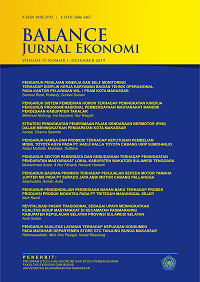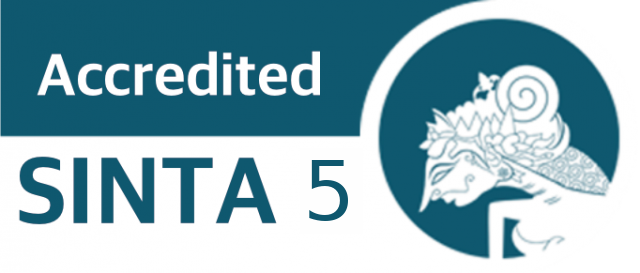Implementation of the Integrated Village Economic Transformation Program (TEKAD) in Efforts to Develop Village Potential and Community Empowerment
DOI: https://doi.org/10.26618/jeb.v20i2.13595
TEKAD Program, Village Potential Development, Community Empowerment, Analytical Hierarchy Process (AHP)
Abstract
This study explores the implementation of the TEKAD Integrated Village Economic Transformation program to enhance village potential and community empowerment in Bea Kakor Village. Employing the Analytical Hierarchy Process (AHP) and Descriptive Analysis, the research identifies key factors crucial to the TEKAD program's success. The prioritized aspects, in descending order, are human resources, infrastructure, natural resources, and institutions. In the contemporary context, many villages struggle to unlock their potential due to historical centralistic development models, resulting in untapped resources and limited creativity. In response, the TEKAD program, initiated under Presidential Regulation No. 3 of 2016, aims to empower rural communities and boost economic development through active community involvement. The study focuses on Bea Kakor Village within the TEKAD program in East Nusa Tenggara, highlighting the pivotal role of human resources, infrastructure, and natural resources. The research utilizes the AHP method to prioritize these factors, emphasizing the significance of human resources in driving economic growth. The findings provide valuable insights for policymakers and community leaders to enhance the effectiveness of TEKAD and similar programs in fostering sustainable development and inclusive economic growth.References
Abdul Wahab, Solichin. 2008. Introduction to Public Policy Analysis. Malang: Muhammadiyah University of Malang.
Adi, Isbandi Rukminto. 2012. Empowerment, Community Development and Community Intervention: An Introduction to Practical Thought and Approaches. Jakarta: UI Faculty of Economics Publishing Institute.
Agus P. H. (2010). Concept of Empowerment, Participation and Institutions in Development. Agribusiness Foundation/Agribusiness Community Development Center (PPMA), 1987.
Apriyanti, Liyana. 2011. "Analysis of the Community Empowerment Program in Alleviating Poverty in the City of Semarang (Case of Implementation of the PNPM Mandiri Urban Revolving Loan Program, Kemijen Village, East Semarang District, Semarang City, 2008-2010)". Unpublished Thesis, Faculty of Economics, Diponegoro University, Semarang.
Arsyad, Lincolin. 2015. Development Economics, Fifth Edition. Yogyakarta: UPP STIM YKPN.
Badudu and Zain, General Indonesian Dictionary. . Jakarta: Sinar Library. Hope, 2001.
Banga. Wempy. 2018. Contemporary Public Administration Review. Concepts, Theory and Applications. Yogyakarta : Gava Media. Book
Bintarto, R. Indonesian Wikipedia, the Free Encyclopedia. (2014), from http://id.wikipedia.org/wiki/Desa.
Charles W. Howe, Natural Resource Economics , John Wiley & Sons, New York, 1979, ch. 1.
Choirullah. 2007. Development Economics.
Dunn, William N. 2000. Introduction to Public Policy Analysis. Yogyakarta: Gadjah Mada Press
Eko Nurmianto. (2018). Community Empowerment Based on Regional Potential.pdf. 3, 68–89. www.sinargamedia.com
Friedman, John, 1992. Empowerment The Politics of Alternative Development. Blackwell Publishers, Cambridge, USA
Kusiawati, D. (2017). Out-of-School Education, Indonesian University of Education Out-of-School Education, Faculty of Education, State University of Malang. Community Empowerment, 2(1), 59–72.
Kumolo, Tjahjo. (2017). Nawa Cita for the Welfare of the Indonesian People. Jakarta PT Kompas Media Nusantara books
Sugiyono. 2010. Bandung Research Methods (Quantitative, Qualitative and R&D Approaches. Bandung: Alfabeta.
Sukirno, Sadono. 1996. Introduction to Macroeconomic Theory. Jakarta: PT Raja Grafindo Persada.
Sumodiningrat, Gunawan (2009) Building the People's Economy, Yogyakarta Student Library
Surata, I. W., & Nindhia, T. G. T. (2017). Potential Development and Community Empowerment in Sakti Village, Nusa Penida District, Klungkung Regency. Ojs.Unud.Ac.Id, 16(September), 401–409. https://ojs.unud.ac.id/index.php/jum/article/download/37303/22607
Suryawati.C. (2005, September). Understanding Poverty Multidimensionally. JMPK, Volume 8(3).
Syafri, Wirman and Irawan Setyoko. 2010. Implementation of Public Policy and Civil Service Professional Ethics. Sumedang: Alqaprint Jatinangor
Tampubolon, H. (2016). Human Resource Management Strategy and Its Role in Developing Competitive Advantage.
Todaro, Michael P. 2006. Economic Development. Ninth Edition, Volumes I, II. Earth Literacy Jakarta.
Udin Nazeer (2015) Poverty Alleviation in India: Intervention of Policies International Journal of Community Development
Winarno, Budi. 2012. Public Policy, Theory, Process, and Case Studies Latest Edition & Revision. Yogyakarta: Media Pressindo.
Yuliadi, Imamudi. 2009. Applied Econometrics. Yogyakarta: Publishing Unit, Faculty of Economics, UGM.
Yulianto, Trimo. 2005. The Phenomenon of Poverty Alleviation Programs in Klaten Regency (Case Study of Jotangan Village, Bayat District). Thesis (Unpublished). Semarang: Diponegoro University
Journal
Kusumastuti, A. (2016). Social Capital and Adaptation Mechanisms for Rural Communities in Infrastructure Management and Development. Society: A Journal of Sociology, 20(1). https://Doi.Org/10.7454/Mjs.V20i1.4740
Mas seenin, M. Z., & Fauzy, M. Q. (2016). Conservation of Natural Resources of Marble Quarries from an Islamic Perspective (Case Study of PT. Industri Marmer Indonesia Tulungagung, Besuki District). Journal of Theoretical and Applied Sharia Economics, 3(11), 915–927.
Mustangin, et al, 2017, Community Empowerment Based on Local Potential Through the Tourism Village Program in Bumiaji Village, Journal of Sociological Thought and Research, Vol. 2, no. 1
Safri, H. (2016). Human Resource Development in Development. Manage: Journal of Islamic Education Management, 1(1), 102-112.
Soleh, A. (2017). Village Potential Development Strategy. Sungkai Journal, 5(1), 32–52.
Law No.22 of 1999
Law No.6 of 2014
Decree of the Minister of Villages, Development of Disadvantaged Regions and Transmigration Number 421 of 2016 concerning Guidelines for Implementing the Integrated Village Economic Transformation Program
Presidential Regulation no. 3 of 2016
Presidential Regulation no. 3 of 2016 concerning Policies for the Empowerment and Development of Micro, Small and Medium Enterprises http://journal.um-surabaya.ac.id/index.php/JKM/article/view/2203RPJMDes Bea Kakor Village 2022-2027












